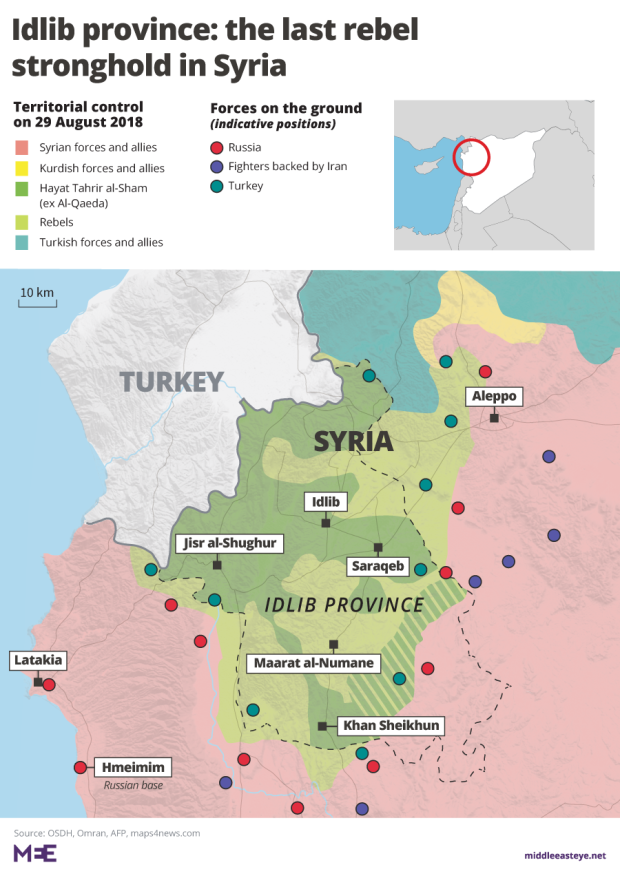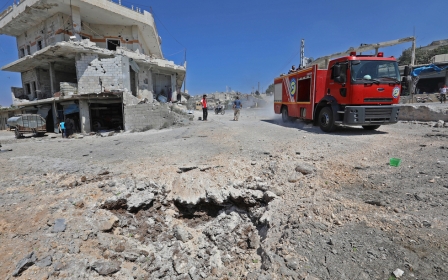Turkish aid officials fear border camps won't cope with huge Idlib influx
ANKARA - The Turkish Red Crescent fears that new refugee camps set up inside Syria could be overwhelmed by a fresh influx of arrivals from Idlib province where pro-Syrian government forces are expected to launch a new offensive within days.
Kerem Kinik, the head of the Turkish Red Crescent, was in Idlib last week to oversee the preparation of the camps, where tents are being set up to host an additional 90,000 people.
But a Red Crescent official who was with him in Idlib told Middle East Eye that the humanitarian organisation expected millions more to seek refuge along the border from the fighting in Syria's last rebel-held stronghold.
We know there are millions who are ready to leave their homes, so we will take the wounded, the elderly, children, and women with children first
- Red Crescent official
"The tents were sent and are ready to be set up. We will host 90,000 people in total. We know there are millions who are ready to leave their homes, so we will take the wounded, the elderly, children, and women with children first," the official told MEE.
“More than two million of them came from other areas of Syria, some from Ghouta, some from Aleppo. Some of them have even changed home [already] more than twice, so they are all prepared for immediate evacuation in case of a military operation.
"They have their tents, sheets, pillows and other vital needs in front of their doors, and they are ready to survive by themselves, at least temporarily. We will see them finding a secure place on the border and create their own living areas if the operation starts."
"That's why we are trying to clear all the areas on the border for them."
Other aid agencies working in the region raised similar concerns on Monday, with Ahmed Mahmoud, Syria spokesperson for aid group Islamic Relief, telling MEE that some people were seeking shelter under trees because they had nowhere else to go.
“People are trying to settle wherever they can in the hope of being protected from the air strikes. Some have even started to move under the trees in the hope that it will save them,” he said.
“When we speak to Syrians who have already been displaced three, five, even six times, they themselves say there is nowhere to go.
“Some even said that they are preparing to die as Idlib is the last safe place for many of them.”
The preparations came as Russian jets and Syrian helicopters on Monday resumed intensive strikes in Idlib and Hama for a third day, with sources saying the Syrian army helicopters were dropping barrel bombs.
Attacks were reported in Jarjanaz, Hass and Hish in the Ma'arrat al-Numan district of Idlib as well as Lataminah in Hama.
Mark Lowcock, the UN's new humanitarian chief, warned on Monday that a large-scale military operation against Idlib could create "the worst humanitarian catastrophe" of this century.
The UN also noted on Monday that 30,000 Syrians were displaced inside Idlib from their homes in northwest Syria after the Syrian government and allied forces resumed air and ground strikes this week.
No plan to open border
On Monday, a senior Turkish member of parliament said that the government in Ankara had no plans to open the border wall to allow Syrian refugees to cross into Turkey.
"There might be another refugee flow but we plan not to open our borders and settle the refugees in the camps prepared for them on the Syrian side of the border," Volkan Bozkir, the head of the Turkish parliament's foreign affairs committee and a former government minister, told the Cumhuriyet newspaper.
"We are taking all the preventative measures to solve the refugee problem within Syria."
About 30,000 people already live in a Turkish Red Crescent-run camp on the Idlib side of the border. The Red Crescent official said the camp had been expanded to host another 60,000 people.
Another camp for a further 20,000 people was being set up close to the border in northern Idlib near the city of Azaz, Bozkir added.
But he called on the international community to offer more support for the expected increase in refugees.Other aid organisations also operate in the area, but their support is mostly limited to providing supplies to civilians already living in the existing border camps.
"The number is very, very little compared to three million civilians in Idlib, but there is no country in the world which can handle that number of refugees in one flow," he said.
Idlib is estimated to be currently home to about three million civilians, including one million children, many of whom have already fled fighting elsewhere in Syria, or have been evacuated there under resettlement deals, as well as tens of thousands of fighters.
Border wall
Turkey, which already hosts about 3.5 million Syrian refugees, built a four-metre wall along the frontier with Idlib in late 2016 to prevent any attacks against Turkey and stop the flow of new arrivals.
But officials admit that the wall has left those stranded in Idlib with little prospect of escape.
Senior Turkish officials, who wished to remain anonymous, last week told MEE that Ankara feared that a new offensive in Idlib would disrupt its plans to send refugees currently living in Turkey back to northwest Syria by the end of the year.
Turkish forces and Turkish-backed opposition fighters currently control an area between Afrin and Jarabulus where Ankara had hoped to resettle the millions of refugees.
But Turkey is now looking to use the area as a potential refuge for civilians trapped in Idlib if it is unable to secure a buffer zone for civilians along the border in the event of a full-scale assault by pro-Syrian government forces.
But there is a further obstacle: the strip of land between Turkey-controlled Afrin and Idlib is controlled by Hayat Tahrir al-Sham (HTS), a former al-Qaeda affiliate.
Human shield fears
HTS is considered a terrorist group by Russia and Turkey, with Russia and the Syrian government using the group's presence in the area as one of the main justifications for its assault.
Turkey is concerned that HTS could seek to use civilians as human shields and prevent them from reaching Afrin.
HTS is also the dominant group in the sprawling Atimeh refugee camp close to the Turkish border, which is already home to about 800,000 people organised in more than 50 different camps, with others setting up tents themselves and living without access to any formal services.
While Turkish and international NGOs and aid workers provide humanitarian aid to about 30,000 people in the camp, sending in more aid has proved impossible.
A further complicating factor for Turkish aid agencies is that many civilians themselves are now carrying arms for protection, making it harder to distinguish them from fighters.
Turkish security sources on the ground in Idlib told MEE that they had visited areas where members of HTS, other fighters and civilians were all living in the same building and all carrying weapons.
The Turkish Red Crescent official told MEE that only civilians who left their weapons behind would be admitted into the organisation's camps.
Middle East Eye propose une couverture et une analyse indépendantes et incomparables du Moyen-Orient, de l’Afrique du Nord et d’autres régions du monde. Pour en savoir plus sur la reprise de ce contenu et les frais qui s’appliquent, veuillez remplir ce formulaire [en anglais]. Pour en savoir plus sur MEE, cliquez ici [en anglais].





